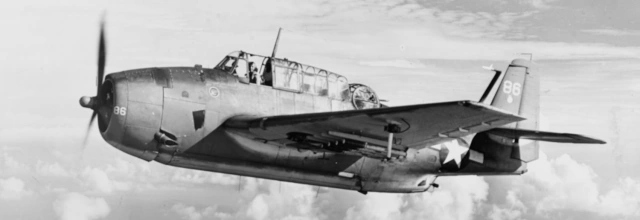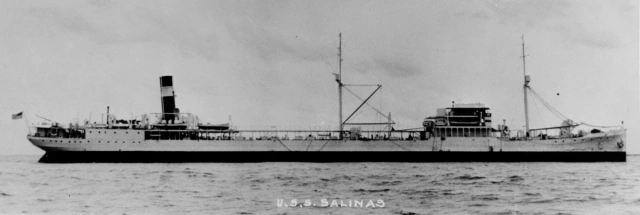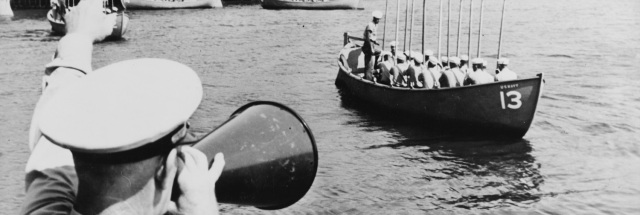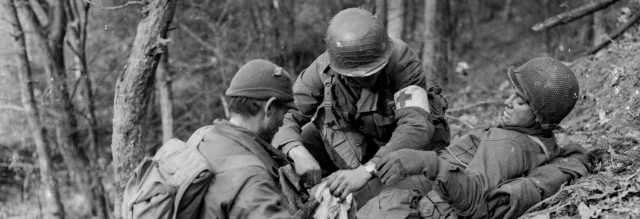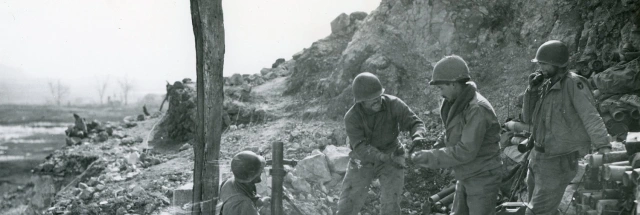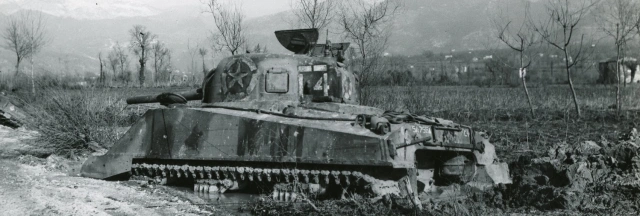
| Home State | Civilian Occupation |
| Maine | Carpenter |
| Branch | Service Numbers |
| U.S. Army | Enlisted 6138885 / Officer O-815251 |
| Theater | Unit |
| European | 708th Bombardment Squadron (Heavy), 447th Bombardment Group (Heavy) |
Author’s note: Delaware’s World War II Fallen occasionally highlights men and women without a direct connection to the First State. 2nd Lieutenant Simmons was in the same B-17 crew as a Delawarean, the late Paul J. Collins.
Early Life & Family
Lowell Francis Simmons was born on January 15, 1918, in Friendship, Maine, the fourth child of Stacy B. (a boat carpenter, 1894–1978) and Mildred C. Simmons (née Burns, 1892–1987). He had three older sisters and three younger sisters. The Simmons family was living on Martin Point Road in Friendship when they were recorded on the census on January 30, 1920. They were living on Bradford Point Rd at the time of the next census, taken on April 19, 1930. Nicknamed Rig, Simmons played basketball, baseball, tennis, and ran track while in high school at Lincoln Academy in Newcastle, Maine. He was captain of the class basketball team during his senior year. He graduated in 1935.
In a letter to the editor printed in the The Lincoln County News on December 29, 2005, Cleveland A. Page recalled:
Lowell, seven years my senior, lived next door to my family home off High Street in Damariscotta. […] Lowell loved to sail on the Damariscotta River – and, it was his generous nature to take me along, I[,] a pesty teenager next door.
It appears Simmons originally joined the U.S. Army shortly after graduating high school. He was stationed at Fort Preble in South Portland as of October 8, 1936. He must have left active duty after November 17, 1938, when The Lincoln County News mentioned that he was still stationed at Fort Preble.
Simmons married Flora W. Worthley (1915–1968) in Maine on November 4, 1938. The couple had a son, Lowell S. Simmons (1939–2019, who like his father, went by the nickname Rig) and a daughter.
When recorded on the census on April 16, 1940, Simmons, his wife and son were living on High Street in Damariscotta, Maine. He was described as a carpenter working in a shipyard—presumably the South Bristol Yacht Building Company, where he was working before rejoining the U.S. Army, according to The Lincoln County News.
Pilot Training
Simmons’s enlistment data card indicates that he was in the U.S. Army’s Enlisted Reserve Corps prior to going on active duty in the U.S. Army Air Forces at Fort Devens, Massachusetts, on February 11, 1943. An August 11, 1949, article in The Lincoln County News stated:
He enlisted and passed his air cadet entrance examinations in August, 1942[.] He was called for flight training in February 1943[.]
His preflight training at Maxwell Field, Alabama was followed by training at Lafayette School of Aeronautics at Greenville Army Flying School at Columbus Army Air Field[.] He graduated with the rank of 2nd Lieutenant in the Army Air Forces in November, 1943[.] He chose heavy bombers and had additional training in the B-17 at Hendricks Field, Sebring, Florida and MacDill Field, Tampa.
In early 1944, Lieutenant Simmons began training with his new crew at MacDill Field, near Tampa, Florida. During a series of interviews in 2020, his bombardier, Major (then 2nd Lieutenant) Paul J. Collins (1923–2021), recalled that Simmons was “self-confident” and “muscular…six feet, maybe 200 lbs. All muscle.” He added, “It helped to be strong flying a B-17…no power assist.” Collins mentioned that with the influx of novice pilots, the accident rate at MacDill was so high, there was a saying: “A plane a day in Tampa Bay.”

Collins recalled that Simmons was an “excellent pilot” who saved the crew one night during a training flight to bomb a practice target in the vicinity of Key West. Although the weather forecast had been favorable, about 20 miles from the target, their B-17 flew into a cumulonimbus cloud. Buffeted by strong air currents, the plane jolted up and then dropped in a stall. The plane fell about 10,000 feet and many of the crew sustained injuries, but Simmons “was strong enough to pull us out.”
Collins jettisoned the bombs and Simmons flew the plane back to the field.
“Simmons, the pilot, and I went looking for that weather guy,” Collins recalled. “We were going to beat the shit out of him and Simmons could do it. He was a big, strong guy that loved trouble. He didn’t go looking for it especially, but boy, he loved when it got there.”
As it turned out, there was no revenge that night against the weather officer, Albert A. Poppiti (1920–2007), who like Collins was from Wilmington, Delaware.
“And he had left,” Collins remembered. “He’d gone on leave. I didn’t see him for five years. And when I saw him the next time, he was my commanding officer in a reserve outfit. […] I told him, ‘Al, you’re the luckiest man alive. I’d… You’d have been beaten. You wouldn’t have been recognizable.’”
Overseas Service & Mission to Berlin
After finishing their training at MacDill in May 1944, Simmons and his crew took a train to Savannah Air Base, Georgia, where they picked up a brand new B-17G. The crew began what was supposed to be a transatlantic flight, but had to divert to Royal Canadian Air Force Station Gander, Newfoundland, after a crew member suddenly became sick en route. The crew mainly subsisted on K-rations.
One day, Lieutenants Simmons and Collins were fishing together at a lake near the field. “We were out in a canoe,” Collins recalled. “A moose came out of the woods while we were on this lake[…] I was going to shoot him with my .45 [pistol]. Simmons was from Maine. ‘Don’t do that,’ he says. ‘You’re not going to kill it, for one thing, and if you hit it,’ he said, ‘then he’ll kill us!’”
Finally, Simmons and his crew were able to complete their flight across the Atlantic Ocean to the United Kingdom. After their arrival at Nutts Corner, Northern Ireland, Simmons and his crew reluctantly parted ways with their plane. They had to travel by boat, train, and bus to reach their assigned duty station in England.
According to Special Order No. 144 (Headquarters U.S.A.A.F. Station 126), on June 11, 1944, the Simmons crew arrived at Royal Air Force Station Rattlesden. Located in Suffolk, southeast England, Rattlesden was home to the 447th Bombardment Group (Heavy) of the U.S. Eighth Air Force. Four days later, they joined the group’s 708th Bombardment Squadron (Heavy).
During the next few days, the Simmons crew flew routine training missions in England. As was customary, Simmons was then assigned to fly a combat orientation mission as copilot with a more experienced crew, led by 2nd Lieutenant Gerald L. Carter (1921–2010). The target was the heavily defended German capital, Berlin.
Carter and Simmons took off from Rattlesden on the morning of June 21, 1944, in a B-17G (serial number 42-97932). The rest of Simmons’s crew remained behind at Rattlesden. According to Missing Air Crew Report (M.A.C.R) No. 5930, filed after the plane failed to return, the B-17 “was hit by flak over target just after bombs away and left the formation under control with #2 [left inboard] engine feathered and a fire in #4 [right outboard] engine.”
Crews in the rest of the formation lost sight of the plane around 1032 hours. German records included in the M.A.C.R. indicate that the B-17 crashed near the Friedrichshagen neighborhood of Berlin around 1054 hours. Although nine members of Lieutenant Carter’s crew parachuted to safety, Lieutenant Simmons was killed.
Carter and the other survivors were captured by the Germans but liberated at the end of the war. The remaining men from Simmons’s original crew survived their missions. The Germans buried 2nd Lieutenant Simmons. After the war, his family requested that Simmons’s body be repatriated to the United States. After services in August 1949, Lieutenant Simmons was laid to rest at the Hillside-Norris Cemetery in Damariscotta, Maine.
Concluding his 2005 letter to the editor, Cleveland A. Page wrote: “The loss lingers on amongst those of us who care.”
Paul Collins echoed that sentiment. Speaking about Simmons’s death over 76 years later, it was clearly still raw to him. “And even today I can’t really describe the feelings… There’s a feeling of unbelief. You couldn’t believe it happened,” Collins recalled. “I always had a guilt feeling. I always felt that if I’d been with him, he wouldn’t been killed. […] But he was a very good pilot. He was very good man.”
Notes
First enlistment
The 1940 census stated that as of April 1, 1935, he was in the “Army [in] Portland”—however, 1936 seems a more likely date of enlistment. A February 13, 1936, article in The Lincoln County News mentioned that Simmons was attending a course at West Point but “that students who enter under these conditions do not have to sign up for any specified service.” However, he enlisted sometime that year, since he was at Fort Preble by October 8, 1936. Assuming a standard three-year enlistment, he would have been discharged sometime in 1939. Regardless, he was back in Damariscotta by April 1940.
Acknowledgments
Special thanks to the late Paul J. Collins for his assistance in preparing this piece and to The Lincoln County News for the use of their photo and archives.
Bibliography
Collins, Paul J. Interview in Wilmington, Delaware, July 13, 2020, phone interview on July 17, 2020, and interviews in New Castle, Delaware, August 28, 2020, September 11, 2020, and September 25, 2020.
“Lincoln Academy Notes.” The Lincoln County News, October 8, 1936. Pg. 4.
“Gerald Lovera Carter Sr.” Find a Grave. https://www.findagrave.com/memorial/63678046/gearld-lovera-carter
“History June, 1944 447th Bombardment Group (H).” Reel B0558. Courtesy of the Air Force Historical Research Agency.
The Lincolnian (1935). https://www.ancestry.com/imageviewer/collections/1265/images/sid_10174_1935_0015
“LT Lowell F. Simmons.” Find a Grave. https://www.findagrave.com/memorial/182372736/lowell-f-simmons
Maine Birth Records, 1715-1922. Maine State Archives, Augusta, Maine. https://www.ancestry.com/imageviewer/collections/1960/images/31515_204136-07914
Maine Marriages 1892-1996 (except 1967 to 1976). Maine State Archives, Augusta, Maine. https://www.ancestry.com/discoveryui-content/view/554020:6904
“Military Services for Lt. Lowell F. Simmons.” The Lincoln County News, August 11, 1949. Pg. 1.
“Missing Air Crew Report No. 5930.” Record Group 92, Records of the Office of the Quartermaster General, 1774–1985. The National Archives at College Park, Maryland. https://catalog.archives.gov/id/90991703
Page, Cleveland A. “Remembering Lowell Simmons.” The Lincoln County News, December 29, 2005. Pg. 4.
“Special Order No. 144, Headquarters U.S.A.A.F. Station 126.” June 15, 1944. Reel B0558. Courtesy of the Air Force Historical Research Agency.
“Twin Village News.” The Lincoln County News, February 13, 1936. Pg. 5.
United States of America, Bureau of the Census. Fourteenth Census of the United States, 1920. National Archives at Washington, D.C. https://www.ancestry.com/imageviewer/collections/6061/images/4300999_00696
United States of America, Bureau of the Census. Fifteenth Census of the United States, 1930. National Archives at Washington, D.C. https://www.ancestry.com/imageviewer/collections/6224/images/4584735_00112
United States of America, Bureau of the Census. Sixteenth Census of the United States, 1940. National Archives at Washington, D.C. https://www.ancestry.com/imageviewer/collections/2442/images/m-t0627-01483-00213
World War II Army Enlistment Records. Record Group 64, Records of the National Archives and Records Administration. National Archives at College Park, Maryland. https://aad.archives.gov/aad/record-detail.jsp?dt=893&mtch=1&cat=all&tf=F&q=06138885&bc=&rpp=10&pg=1&rid=155755
Last updated on November 23, 2021
More stories of World War II fallen:
To have new profiles of fallen soldiers delivered to your inbox, please subscribe below.




